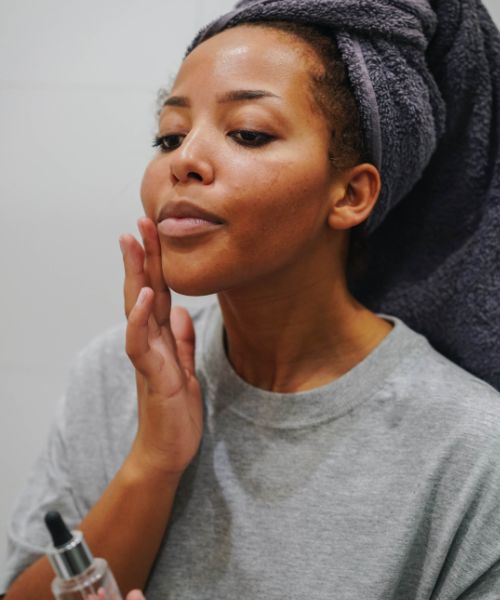Using vitamin C and niacinamide in your skincare routine can be a great way to help improve the overall look and feel of your skin.
Both ingredients are antioxidant powerhouses that can improve clarity, brightness, evenness, and hydration.
However, while you may be excited to try both of them at the same time, knowing how to layer vitamin C and niacinamide is key to correctly using the actives and maximally benefiting from them.
Therefore, in this article, I will talk about both actives, how they work, how to layer them for best results, and what are some side effects you need to watch out for when testing this potent combination of brightening components.

How Does Vitamin C Work?
Vitamin C is an antioxidant that helps reduce the damage done to the skin by free radicals, which are unstable molecules found in the environment that degrade vital parts of cells, including their membranes, proteins, and DNA, by stealing their electrons through a process called oxidation.
This leads to visible consequences like dullness, uneven skin tone, discoloration, premature lines and wrinkles, and even acne.
However, antioxidants like vitamin C have been noted to scavenge free radicals, which helps keep our skin healthy and youthful, even out the skin tone, reduce the appearance of fine lines and wrinkles, and reverse the damage done by uneven melanin distribution, such as brown spots.
Lastly, vitamin C also has some anti-inflammatory properties and can help reduce redness and blemishes in some cases.
The Benefits of Vitamin C:
- Lightens dark spots and hyperpigmentation.
- Helps protect the skin against environmental and UV damage.
- Reduces free radical-induced inflammation in the skin.
- Brightens the complexion.
- Evens out uneven skin tone.
- Refines coarse skin texture.
- Improves discoloration.
How Does Niacinamide Work?
Niacinamide is a form of vitamin B3 that has been shown to be effective in improving a number of skin concerns, including acne, uneven skin tone and texture, post-inflammatory hyperpigmentation, post-inflammatory redness, and rosacea.
Niacinamide is also a gentle ingredient that’s easy to formulate and works well with most other ingredients found in skincare, which is why it’s commonly included in anything from cleansers, toners, serums, moisturizers, and even sunscreens.
It is also generally well-tolerated, making it suitable for all skin types, and it can be used both morning and night.
The Benefits of Niacinamide:
- Reduce inflammation and redness.
- Reduces the severity of acne.
- Refines the appearance of enlarged pores.
- Fades hyperpigmentation.
- Improves the skin barrier’s function.
- Hydrates, plumps, and encourages the skin to become more resilient.
- Balances the pH of the skin.
How to Layer Vitamin C and Niacinamide?
The unwritten rule of combining both actives is to apply vitamin C first and follow up with niacinamide, as the first active on clean skin should be the one with a lower or slightly acidic pH that will prep the skin’s surface for better absorption.
Vitamin C usually has a pH of 3, whereas niacinamide works optimally at a slightly higher pH of between 5 and 7, making it the perfect follow-up product to balance the skin’s pH and maximize the efficacy of both actives.
Additionally, you should also leave a few minutes in between the application of both actives, allowing enough time for each product to settle on the skin, as this will reduce the risk of pH clashes.
However, a couple of other things may come into play when layering both actives, so with that said, here are two other ways to layer vitamin C and niacinamide:
Based on Consistency
You can’t go wrong when layering your skincare products based on consistency. Therefore, if you are wondering whether you should use your vitamin C or your niacinamide first, the answer is simple: start with the product that has the lightest consistency.
If you have a niacinamide toner and a vitamin C serum, it makes the most sense to use the niacinamide toner first, as the lighter consistency will mean it’s absorbed more quickly and easily, making way for the heavier serum.
On the other hand, if both your vitamin C and niacinamide are serums, try to identify which one has a thinner texture and opt for that as your first step.
Using products with a thicker consistency first, like a vitamin C serum, can interfere with the penetration of the lighter products and in turn, limit their effectiveness.
Based on Other Skincare Products in Your Routine
If you are using vitamin C and niacinamide in your morning routine and you are going to apply makeup after doing your skincare routine, some products might not agree with certain ingredients in your actives.
For example, if your niacinamide serum contains silicones, it might be better to use it on top of vitamin C as makeup products such as concealers and foundations may stick better with silicones and last longer thanks to the agreeable base.
So, through experimenting, try to figure out which order of application works best with your other makeup products as well and stick with what works for you.
Based on Preference
At the end of the day, it all comes down to personal preference. If you prefer having your vitamin C product first so that the niacinamide can help buffer its acidity, that’s fine!
On the other hand, if you’d rather start with niacinamide and then follow up with a vitamin C product, that’s also perfectly fine.
Ultimately, the important thing to remember here is that layering these activites with a few minutes in between simply helps to ensure that both are properly absorbed and can work together to deliver the best results.
Side Effects of Using Vitamin C and Niacinamide Together

While using vitamin C and niacinamide together can lead to a brighter, more even, refined, and glowy complexion, this combination doesn’t come without the risks of experiencing a few side effects should you overuse both actives and compromise your skin barrier in the process.
The most common side effects of using vitamin C and niacinamide together include:
Irritation
Irritation may occur when using vitamin C and niacinamide together for several reasons:
- High concentrations of both actives.
- Using both actives too frequently.
- Using both actives with other strong actives such as retinoids, exfoliating acids, or acne medication.
- Not using an adequate moisturizer, which may lead to dryness and subsequent irritation.
- Not using sunscreen.
Breakouts
Another clear sign of irritation when using vitamin C and niacinamide are sudden breakouts after a little while of using the combination.
This usually means that you are using a high concentration of a product your skin doesn’t like or you are using an oily product that is clogging up your pores and causing your skin to break out.
Peeling
Peeling, shedding, and redness, especially in areas around the mouth are other signs of irritation due to the potent combo.
If you start experiencing these symptoms soon after introducing the actives into your routine, it would be best to reduce the frequency of use or consider using vitamin C and niacinamide in separate routines and see how your skin will accept both actives.
Again, introducing too many active ingredients in a short period of time is the main culprit when it comes to skin irritation, so try to avoid making this mistake if you want your skin to be clear, healthy, and more unified.
Constant irritation leads to inflammation, which then manifests on the skin as conditions such as acne, dermatitis, and rosacea, which can be incredibly difficult to treat and are often permanent issues that can only be maintained but will keep coming back whenever the skin barrier is compromised.

My name is Simone and I am a certified skin specialist. I created this website to teach my readers how to take great care of their skin and I also like to occasionally share my honest opinions on skincare products I’ve tried. You can learn more about me here.
